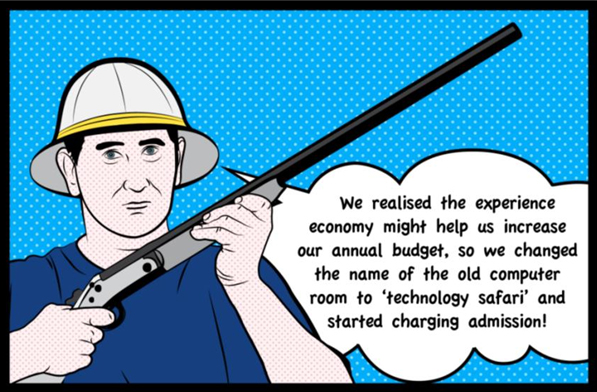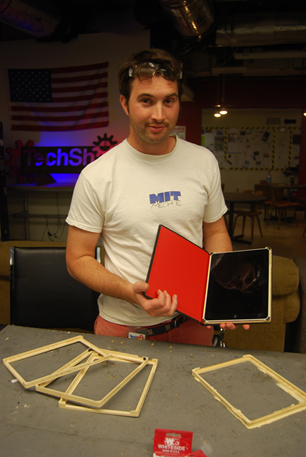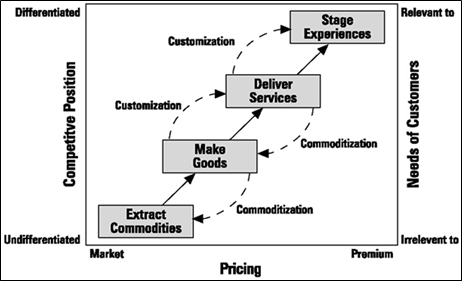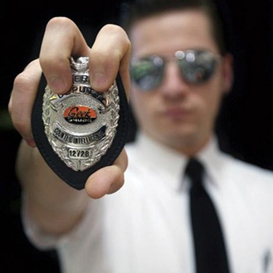CIO SURVIVAL GUIDE PART 6: SUCCEEDING IN THE EXPERIENCE ECONOMY
You Are What You Charge For
WHETHER IT IS FROM TECHNOLOGY CHANGES, COMPETITIVE PRESSURE OR CHANGES OF CUSTOMER EXPECTATIONS, EVERY BUSINESS IS IN CONSTANT DANGER OF BECOMING A COMMODITY. REALISING THAT CUSTOMERS WILL PAY MORE FOR EXPERIENCES THAN GOODS AND SERVICES MUST BECOME A PILLAR OF YOUR STRATEGY. THE CIO IS PERFECTLY POSITIONED TO CHAMPION THE TRANSFORMATION REQUIRED FOR THEIR COMPANIES TO SURVIVE IN THE EXPERIENCE ECONOMY.
By Chris Parker
Your job as the CIO is also in constant danger of being commoditised. The days when you can simply charge for delivering a high quality service are over. There are too many other parties who can deliver these services cheaper and better than you can. An obvious alternative for your services are external parties, who are constantly improving their customer experience and reducing their costs. Fellow executives who used to be captive customers are now hiring their own technology specialists and are going to market without you. A more recent threat to your future are your users. Attracted by the amazing user experiences, they are now able to deliver their own information needs with solutions easily available from the cloud. A strategy based on the delivery of information services has no chance of survival against these market forces.
The dynamics which are pulling you towards the commodity trap are in affect in every industry. Another way to demonstrate this is to consider a cup of coffee. If you ran an internal coffee roasting and brewing department it is unlikely you would have survived the introduction of the office coffee machine. Even if you adopted a professional coffee machine, you would be under pressure from the secretaries who are following George Clooney’s advice and are demanding a Nespresso! In order to develop a sustainable strategy you need to decide which type of economic value you have the ambition to deliver.
The lowest level of economic offering is a commodity. In this case, coffee beans sold in bulk. Additional value can be added to coffee by processing and packaging the beans into bags for resale, or even further by delivering a cup of coffee as a service. The amount paid by customers per coffee bean increases significantly as one moves from commodity to goods to services to experiences. The value proposition of Starbucks is much more than just a cup of coffee. The store design, the staff, the music and the other products for sale all contribute to make buying a Starbucks coffee a more enjoyable and memorable experience. Customers are willing to pay much more for that experience than they would for a cup from a machine or even a typical restaurant.
In every industry there are opportunities to move from delivering services to staging experiences. An unlikely industry to find an economic offering based on experiences is in the machine shop – an industrial building with heavy machinery where people manufacture tangible products.
Build Your Dreams Here
There is an amazing trend where regular people are making extraordinary things. Due to the constant and exponential reduction of the cost of technology, these regular people – who often call themselves Makers – are actually making physical products which would have been impossible not long ago. This is happening in garages, basement workshops and other hackerspaces around the world. Why not go to the moon? A group of friends have joined together to form Team Pheonicia and are building a lunar lander with the hopes of winning the Google Lunar X Prize (www.googlelunarxprize.org). They are building their dream moon vehicle at TechShop, a cooperative machine shop in Silicon Valley.
For about $100 a month, you get access to over a million dollars of some of the worlds highest quality machines, tools and software. Maybe even more important than the equipment is the vibrant community of Makers who are always buzzing around the place. The first TechShop (www.techshop.ws) opened in California in 2006 and covers almost 1400 square metres. Walking through the building is an experience in itself, as each of the individual work places have different purposes. A room for cutting and welding metal. Another room for injecting plastic. 3D printers. Laser and plasma cutters. Band saws. Sewing machines. They even have whole wall of little baskets of scrap material which Makers have left behind in the hopes that someone can use it to make their own dream become reality.
TechShop was the first membership based, do-it-yourself (DIY) workshop and fabrication studio and is currently located in four cities in the United States. They have ambitions to expand further nationally and have mentioned the possibility of a television show. According to Mark Hatch, the CEO of TechShop, “We help people make the things they dream up, but don’t have the tools, space or skills to accomplish on their own. And we make sure that every visit to TechShop is its own unique and engaging experience.”
The experience is facilitated by TechShop employees, who are called Dream Coaches. The magic happens when passionate Makers are pursuing their dreams surrounded by an enthusiastic and supportive community of other Makers. Somewhere between 30-60 percent of the members have ambitions of selling whatever it is they are making.
Sometimes, the projects really become amazing successes on their own, for example the DODOcase (www.dodocase.com), which is an iPad case that looks like a book. All the prototyping and early production runs were done at TechShop. Ninety days later they had a business that had sold over a million dollars worth of product. The journey started with the simple question to a Dream Coach, “What classes do I need to take to learn how to make an iPad case out of bamboo and book binding?” Who knew at that time that they would see President Obama on national television with his iPad which was covered in a DODOcase?
TechShop Member Patrick Buckley with his DODOcase prototype.
Some of the dreams which have become reality at TechShop may be of direct interest to CIO’s. For example, Clustered Systems (www.clusteredsystems.com) sells a liquid cooling system for data centre’s which can reduce the energy consumption for cooling by up to 50%. The founders of Clustered Systems spent a year building the initial prototypes in TechShop, and now the company is struggling to keep up with demand.
TechShop enables Makers to do what used to be impossible. By designing a membership-based business model, they have brought people in contact with the technologies they need to make their dream come true. All this for about $100 a month, and it comes gift wrapped in a magical experience. Mark Hatch, their CEO, summed it up nicely by saying, “for the cost of a Starbuck’s addiction you can have access to all the tools of the industrial revolution.”
Welcome to the Experience Economy
In the Experience Economy, companies develop their strategies to charge a premium for the experiences they are providing. Often, a company will give away the good or service because they know they can make a much larger margin on the experience. You are what you charge for. Are you still competing in the Service Economy?
The Experience Economy first entered the business lexicon in the late 90’s when the book by the same name was published by Joseph Pine II and James Gilmore. They have published an updated edition of the Experience Economy this year. Many of the improvements to the thinking have been based on the impact of technology on the ability of companies to deliver meaningful and memorable experiences. The theory introduced in their book is represented in the Progression of Economic Value model. There is fierce pressure pulling towards commoditisation and a strategy of constant customisation is required to maintain a competitive experience-based offering.
Progression of Economic Value, Experience Economy Updated Edition, Pine & Gilmore 2011
The Experience Economy is the foundation on which the entertainment business has been built. Customers are willing to pay for the feelings and memories they experience during and after the performance, as opposed to simply paying for the activity of receiving a service. Experiential Marketing brings entertainment to the customers of traditional businesses, however this is often a marketing strategy as opposed to a core vision of an organisation.
Customers increasingly refuse to accept mere services or be simply entertained by a company’s latest marketing campaign. Customers today know there are options. They are looking for more meaningful experiences and they now have the means through social media to find suppliers who are willing to offer it to them. This is why a CIO must understand the Experience Economy if he or she wants to survive. The Service Economy was based on access to information, and most CIO strategies are designed to meet that need. The Experience Economy is based on knowledge. The successful CIO strategies in the future will be designed to ensure people have access to relevant knowledge whenever and wherever they need it. Without this knowledge being immediately available, a company will not be able to consistently deliver their unique and meaningful experiences.
Dreaming of White Socks
If TechShop has made a unique experience for the do-it-yourself community, then company of computer nerds called Geek Squad (www.geeksquad.com) has designed an experience for the other half of the world. To meet the needs of technology users who don’t want to do-it-yourself, Geek Squad has wrapped their experience up in the clothes of a police officer. The motto of their 20,000 Special Agents, Double Agents and (inside stores) Counter Intelligence Agents is: “Serving the Public, Policing Technology and Protecting the World.”
Chief Inspector Robert Stephens founded Geek Squad with $200 and a bicycle in Minneapolis in 1994. Today, Geek Squad is the leading local technology support service in the United States. They provide consumers nationwide with a task force to help them manage their growing dependence on technology. Geek Squad has since expanded internationally and opened a Precinct in the Netherlands earlier this year.
The basic service that Geek Squad provides is a commodity. If they simply provided technology support as the basis of their value proposition, they would be no different than any other computer repair store. The magic of their value proposition is in the show they put on while delivering the service. Customers pay for the experience of having the Geek Squad come to their rescue, not the simple fact that their computer is repaired. Geek Squad Agents have a strict dress code – wearing black suits with thin black ties. They drive small cars which have been decorated to resemble police cars. When they arrive on the scene, they even have fun by acting the part as well, for example asking the customer to “step aside ma’am, Geek Squad here to save the day!”
A Geek Squad Agent proudly showing off his badge.
The primary purpose of the Geek Squad is to provide an entertaining experience while fixing the computer problem. They have not set out to solve the computer problem in an entertaining way. Although subtle, the difference is mindset crucial. This experience oriented mindset comes through in everything they do, in particular in their recruiting policy. Their website explicitly states “This uniform doesn’t fit everyone.” People who apply to become Geek Squad Agents must really want to be part of that culture, as part of the uniform is also the special socks: “White athletic crew socks: our socks are always on show, so we keep them completely spotless and bright white.”
What Do You Charge For?
You should not wait too long before refining your strategy to exploit the Experience Economy. Competition is actively working to fill this role for your company if you don’t. Forrester Research recently recommended companies to consider creating a Marketing Technology Office1, which is described as “A centre of excellence that leads technology strategy, develops marketing technologies, and evangelizes innovative uses throughout the marketing department.” There is a growing population of Makers among your users and they aren’t waiting for you to deliver more services.
Your technology organisation can’t simply dress up like policemen and walk around with badges attached to their belts to engage successfully in the Experience Economy. A fundamental change in mindset is required. How would the Makers and the Marketing Department in your company respond if you provided them with Dream Coaches to facilitate their experience? They are now able to provide their own information services. What they need now is access to knowledge which allows them to stage their own experiences for your external customers. How would your organisation look if you were delivering such a knowledge experience instead the current information services? How would you behave differently if you charged admission to this experience?
Customer are willing to pay more for a memorable experience. Technologies to provide unique experiences are becoming more affordable every day. Competition from every direction is looking to exploit this opportunity. The Experience Economy is here. It is happening right now. The question now is what part will you play? Now is the time to go find your special cup of coffee. Your moon lander. Your white socks. Discover whatever it is that will provide you a unique and meaningful experience. Go build your dream.
This is the last edition of the CIO Survival Guide. My dream has been to help you succeed as a CIO by entertaining and confronting you with inspirational case studies in various fields of interest: User Experience, Customer Service, Customer Relationship Management, Employee Experience, Customer Experience Management and now the Experience Economy.
Chris Parker ([email protected]) is a customer experience expert and helps business leaders around the world improve customer experiences by embracing emerging technologies.
The CIO’s Experience Economy Survival Action List:
- Discover and participate in inspirational experiences with your team.
- Assess your current services on how meaningful and memorable they are.
- Adjust your mindset accordingly.
- Test your environment to see how they respond when you start staging experiences.
- Partner with suppliers who can provide information services better than you can.
- Make friends with the CEO and make sure this important customer is willing to pay a premium for the experience you are providing!
Resources on the Experience Economy for the CIO
The Experience Economy, Updated Edition by B. Joseph Pine II and James H. Gilmore (2011)
Infinite Possibility: Creating Customer Value on the Digital Frontier by B. Joseph Pine II and Kim C. Korn (2011)
Creating Experiences in the Experience Economy by Jon Sundbo and Per Darmer (2008)
TED Talks: Joseph Pine on What Consumers Want (on.ted.com/9uSG)
European Centre for the Experience Economy (www.experience-economy.com)
TechShop Opens in San Francisco (youtu.be/V2M9h1cPNBo)
1Investing In Marketing’s Technology Future – Forrester Report by Robert Brosnan (2011)
Experience Economy Expert Certification (www.strategichorizons.com/certification.html)




